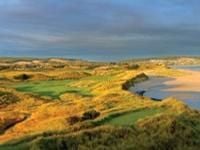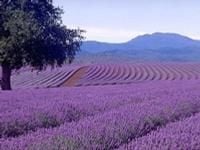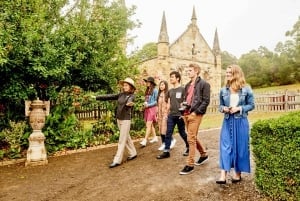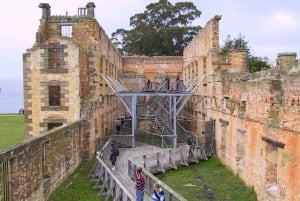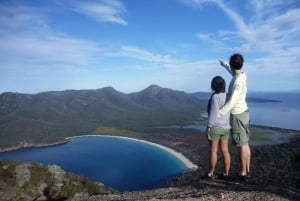North East
North East Tasmania
The North Eastern tip of Tasmania is a rural district featuring lush grasslands, dense forests and along the coast secluded beaches, on which you will struggle to find a footprint. This is Tasmania’s agriculture and forestry district and many of the area’s small country towns have flourished on its rich and fertile soil.
Gold was discovered near Fingal and in a few other spots around 1850 and set off a short-lived gold rush. A few decades later the discovery of tin triggered another boom, which saw 1500 Chinese workers working 150 tin mines and at one stage the richest tin mine in the world operating in Derby. Follow the Trail of The Tin Dragon from Launceston to St Helens which charts the story of the mines, the miners, their successes and disasters, and the coming together of two vastly different cultures.
Today visitors are drawn to Tasmania’s North East for its abundant wildlife and pristine nature. The area provides a nourishing home to Tasmania’s highest population of Forester kangaroos. The North East is where you can enjoy beautiful secluded beaches, breathtaking National Parks, tour a number of cool climate vineyards, and play Australia's number one public access golf course. The North East is also home to Tasmania's major downhill ski resort, situated at Ben Lomond.
The North East has a myriad of walking tracks in all grades and lengths from the wheelchair friendly, 20 min return, Goblin Forest Walk at Blue Tier to the awesome Bay of Fires Lodge 4 day guided walk.
Ben Lomond
The popular Ben Lomond National Park is only a short drive from Launceston. It is Tasmania’s best skiing destination, but the magnificent scenery makes the park a much-loved holiday spot year-round. Two cross country ski routes, which are marked by snow poles, serve as hiking routes during spring and summer, when alpine wildflowers cover the landscape like a colourful blanket. Access latest ski and snow reports.
With 1572 metres, Legges Tor is the highest peek of the Ben Lomond plateau. This is the second highest point in Tasmania, visible over much of the northern midlands of Tasmania. On the southern side of the plateau you can enjoy magnificent views across the valley from the 1527-metre high Stacks Bluff.
The park offers a rich habitat to many Tasmanian species. Bennett’s wallabies and wombats are common, so are pademelons and Forester kangaroos. Eastern quolls, echidnas, antechinus and platypus have also been spotted here. Tasmanian devils used to be common, however their numbers have decreased sharply during the past two decades. There is also an abundance of bird life.
You can reach Ben Lomond on an unsealed road. The last part is known as Jacob’s Ladder, a steep and winding road, which has recently been upgraded. During winter this road might be covered by ice and snow and can be closed without notice. Wheel chains must be carried between June and September
The Creek Inn at the ski village offers accommodation and food. Camp sites are also available. The park is within easy reach from Launceston, which offers a much larger range of options for accommodation and dining.
Scottsdale and Bridport
The small and tidy country town of Scottsdale prospered on the district’s rich agricultural and forestry background. The Forest EcoCentre, which is run by Forestry Tasmania, hosts an exhibition on the local landscape and its forestry history. Also nearby is the Bridestowe Lavender Farm with 44 hectares of lavender and landscaped gardens. This is an amazing sight when the lavender is in full bloom and the scent of the flowers fills the air. Lavender oil products are available as are self-guided tours.
The laid-back little fishing village of Bridport lies 21 km north of Scottsdale on the coast. In summer the local population frequently triples with holiday-makers swarming in to enjoy the white sandy beaches and fresh seafood. Nearby reserves such as the Granite Point Coastal Reserve or the Bridport Wildflower Reserve make excellent day trips during your holiday in Bridport and feature waterfalls, sand dunes and native wildlife. Bridport is also the gateway to Flinders Island, which can be reached by air or sea.
Bridport is also home to two of the worlds greatest golf courses Barnbougle Dunes, ranked as Australia's number one public golf course and the 26th best course in the world and Lost Farm ranked at number 38. Set on 200 acres of undulating coastal dunes and created by famed golf architect Tom Doak and Australia's Michael Clayton Barnbougle is one of the world's top links golf courses. Lost Farm is a 20 hole Links Golf course designed and constructed by world renowned US golf course design company Coore & Crenshaw and is adjacent to the Barnbougle Dunes Course. The breathtaking landscape of these two courses mirrors the wild coastal links courses of Scotland and Ireland.
Mt William National Park
If you are looking for a piece of pristine nature, this is the place to come. The area was once declared a national park to protect its native Forester kangaroo and other native animals. Today, these and other Tasmanian species are abundant here and wildlife spotting is a favourite activity in the park. A stroll through the coastal heathlands or even along the beach at dawn or dusk is almost a guarantee to see kangaroos, wallabies and wombats. With a bit of luck you might encounter pademelons and echidnas as well.
This is also a paradise for self-sufficient hikers, who can enjoy splendid views from the park’s few elevations as well as long and deserted beaches. You can reach the top of Mt William in an easy 1-1/2-hour walk from the car park. Although it is only 216m high, it offers some splendid views across the coast.
The Eddystone Point Lighthouse at the southern end of the park marks the state’s most easterly point. A few basic camp sites are available, however, travellers need to bring their own drinking water.
Mt William National Park can be accessed from Gladstone, travel 17 km (on gravel roads C843 and C845) to the Park entrance at the northern end of the park. Eddystone Point can be reached by gravel roads (C843 and C846) from St Helens via Ansons Bay. Its remote location has kept the park an insider tip, which has eluded the crowds despite its intriguing beauty.
Bay of Fires Conservation Area
Ranked second most beautiful beach in the world by Conde Nast Traveller in 2006 this remarkable stretch of coast is sure to leave a lasting impression in your memory: turquois ocean, white sandy beaches and granite rocks shimmering with bright orange lichen form an unforgettable visual triad. The area’s pristine and unspoilt nature is another attractive feature.
From St Helens the Binalong Bay Road takes you north to the small holiday town of Binalong Bay, where you will find plenty of options for dining and accommodation. From here The Gardens Road takes you up to The Gardens.
The northern part of the bay between The Gardens and Ansons Bay is only accessible on unsealed roads or on foot. The area offers spectacular hiking, but you need to be well prepared. The Bay of Fires Walk ranks among Tasmania’s best multi-day guided walks.
From Launceston to St Helens
The tiny former tin mining town of Derby offers a good place to stretch your legs on the journey between Launceston and St Helens. The main attraction is the Tin Dragon Interpretation Centre & Cafe that hosts an exhibition and a multimedia show on the area’s short-lived tin boom. The centre is also the heart of the Trail of the Tin Dragon, which tells the tale of the Chinese and European tin miners.
For a time, the small town of Derby was the richest tin mine in the world. With water providing the energy for the stamping mills the company built water races and then a dam above the town. The dam was pronounced up to the task and that it would never fail. In April 1929 after having rained for five days straight and then a final downpour of 5 inches in just two hours, it burst and a billion litres of water rushed down the valley taken everything with it.
Further southeast along the road towards St Helens is the idyllic little village of Weldborough. The rustic Weldborough Hotel offers good counter meals for lunch and dinner as well as pub-style accommodation and camping. The short Weldborough Rainforest Walk takes you along some old Myrtle trees and gives information about the critical state of Tasmania’s rain forest.
The St Columba Falls State Reserve and the tiny township of Pyengana are worth the short detour off the main road. From the reserve’s car park a short walk takes you to the viewing platform of the St Columba Falls – one of the state’s highest waterfalls, dropping around 90m. Taste the region’s award-winning cheeses in the Holy Cow Café run by the Pyengana Dairy Company. The café also serves meals and drinks and sells souvenirs.


